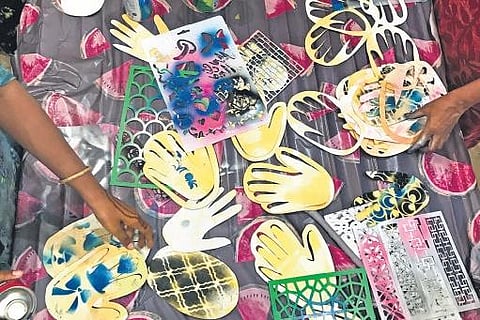

KOCHI: Women have long been associated with kitchens, which echo their life experiences. This experimental public art project titled ‘Who Put Out The Fire?’ is conceptualised by Kochi-based art curator and writer Tanya Abraham, who is part of The Art Outreach Society.
Concerning gender identities in a society built through patriarchal structures, this project is a relook into the position of women and their identities with respect to kitchens, a space inextricably linked to women (especially in India).
“This is part of a three-layered project titled ‘A Place at the Table; Where is Amma?’. The project has been going on for the past month involving the house kitchens of six women from Mattancherry and Fort Kochi. It explores the power and possibilities of art practices to express societal notions and an understanding of the presence of social constructs.
Themes such as confinement, constraint and also elements of power in the kitchen reflect in her art. The kitchen represents all these. The confinement comes from restrictions put on women from venturing out and constraints from stopping them from saying or doing specific things. And gradually, these kitchens also transform into a domain of the women who inhabit them. Women wield a certain kind of power in that domain.
“The responsibility of nourishing the family is on the woman’s shoulders. Some of the families we worked with at Mattancherry area were very conservative Muslim families, who solely ran the kitchen and the households,” shares Tanya.
“There was a woman who didn’t like to cook. Once a good baker, she stopped baking after her grandmother died. She doesn’t bake even now. For her, the kitchen and cooking were sweet memories associated with her grandmother. It shows the interrelatedness between people and how food and kitchens play an important part in these,” says Tanya.
According to her, the kitchen, food and the woman’s position of structured servitude or situated positions are broken to reveal where they stem from (socio cultural frameworks). “They opened up to reveal layers of their identity and existence,” says the curator.
Kolkata-based artist Moutushi Chakraborty created a sugar sculpture of a tongue because the homemaker she worked with shared that she loved sweets. Moutushi used the colour green because the homemaker hailed from a Muslim family and green represented piety.
Cooking as an art form
Tanya calls her piece ‘participatory art’. “I want to bridge the gap between the public and contemporary art practices by studying its capacity to address societal needs. Food and cooking in homes act as memories of customs and traditions, within which gender identities are situated.”
The participating artists include Kerala Lalithakala Akademi Chairman Murali Cheeroth, Priti Vadakkath, Justin Ponmany, Moutushi Chakraborty, Sanchayan Ghosh and Babu Eshwar Prasad. The artists set out and visit the women and their kitchens. The women in the households share their experiences in the kitchen and their lives.
Tanya feels that after several interactions, women recreate their kitchens as expressions of their lived experiences. “They question not only their relationship with the kitchen but the possibility of it as a symbol of political reasoning or ideologies.”
Artist Sanchayan Ghosh, who worked with a homemaker named Viji Ramesh was impressed by her determination to be someone more than who cooks for her family. “She shared that she always loved cooking and never felt it was a task. She also talked about how her mother’s kitchen looked smoky black after years,” says Sanchayan.
Tanya will document the project as short films which will be exhibited from December 11 onwards at Devassy Jose & Sons Warehouse, Mattancherry, during the Kochi Muziris Biennale.
The exhibition will have films and video installations, all revolving around the idea of gender roles. Those women interested can also share their gender identities through mini installations in their kitchens.